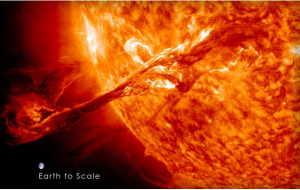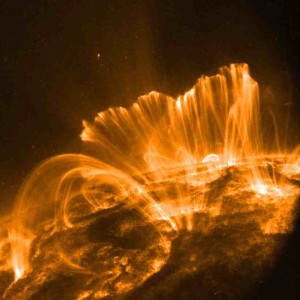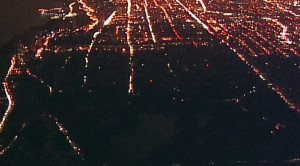 In 1859, a storm like no other in human history ravage the planet. Oddly enough, it was neither rain, nor snow, nor hurricane winds that did the damage. This storm sprang from 93 million miles away and took the form of a coronal mass ejection. The solar flare caused telegraph stations across the globe to spontaneously combust, and lit the stratosphere up with auroras seen as far south as Puerto Rico.
In 1859, a storm like no other in human history ravage the planet. Oddly enough, it was neither rain, nor snow, nor hurricane winds that did the damage. This storm sprang from 93 million miles away and took the form of a coronal mass ejection. The solar flare caused telegraph stations across the globe to spontaneously combust, and lit the stratosphere up with auroras seen as far south as Puerto Rico.
 That maelstrom, referred to as the Carrington Event, as it was observed by British astronomer Richard C. Carrington, created one of the most powerful geomagnetic phenomenon in modern history. Fortunately, there were few catastrophic consequences in 1859.
That maelstrom, referred to as the Carrington Event, as it was observed by British astronomer Richard C. Carrington, created one of the most powerful geomagnetic phenomenon in modern history. Fortunately, there were few catastrophic consequences in 1859.
 Thomas Edison was still a kid, illegally hawking self-printed newspapers on steam-powered locomotives. Had this flare punctured the Earth’s magnetosphere thirty years later when his power stations dotted the country, and Westinghouse’s electrical transformers were lighting up most major cities, the devastation would have been far more pernicious.
Thomas Edison was still a kid, illegally hawking self-printed newspapers on steam-powered locomotives. Had this flare punctured the Earth’s magnetosphere thirty years later when his power stations dotted the country, and Westinghouse’s electrical transformers were lighting up most major cities, the devastation would have been far more pernicious.
 The good new is that ejections this potent only occur every 150 years. The bad news is, we’re overdue for a whopper, and have already dodged an inconceivably large bullet. On July 23rd, 2012, a massive solar eruption missed the earth by a few days. Leading scientists estimate that had the part of the sun responsible for the burst been facing us directly, it would have taken civilization roughly ten years to recover, with repairs costs reaching double digit trillions, assuming we hadn’t killed each other in the ensuing chaos.
The good new is that ejections this potent only occur every 150 years. The bad news is, we’re overdue for a whopper, and have already dodged an inconceivably large bullet. On July 23rd, 2012, a massive solar eruption missed the earth by a few days. Leading scientists estimate that had the part of the sun responsible for the burst been facing us directly, it would have taken civilization roughly ten years to recover, with repairs costs reaching double digit trillions, assuming we hadn’t killed each other in the ensuing chaos.
 A direct hit of subatomic solar particles would affect all satellite activity, debilitating electrical grids, communications, transportation, banking and government, if not knocking them all out completely. We would have natural gas for a while. Propane and diesel generators, but limited electrical power to properly refine those fossil fuels would eliminate them in time. We’d be thrown back to pre-Industrial Age technology soon enough. And wouldn’t that be nice?
A direct hit of subatomic solar particles would affect all satellite activity, debilitating electrical grids, communications, transportation, banking and government, if not knocking them all out completely. We would have natural gas for a while. Propane and diesel generators, but limited electrical power to properly refine those fossil fuels would eliminate them in time. We’d be thrown back to pre-Industrial Age technology soon enough. And wouldn’t that be nice?
 On the positive side, none of us will have to worry about the relentless updating of social media. We’ll also be able to see thousands of stars at night, instead of the nine we get in most major cities. We’ll have a few years of utterly jaw dropping Aurorae which would fill up our nights nicely now that binging Netflix is ancient history.
On the positive side, none of us will have to worry about the relentless updating of social media. We’ll also be able to see thousands of stars at night, instead of the nine we get in most major cities. We’ll have a few years of utterly jaw dropping Aurorae which would fill up our nights nicely now that binging Netflix is ancient history.
 Teenagers will have to learn to make eye contact, since their smart phones won’t be powered. Swiping left and right will also be a thing of the past. They’ll have to attempt conversation to get dates.
Teenagers will have to learn to make eye contact, since their smart phones won’t be powered. Swiping left and right will also be a thing of the past. They’ll have to attempt conversation to get dates.
 Books will see an epic resurgence as highly valued commodities. Raw cuisine will be all the rage. And most importantly, live theater and unamplified music will dominate entertainment. No band will have to make a video. No author will have to do a book tour. The oral tradition of reciting Homer’s Odyssey for three straight days will be back in vogue.
Books will see an epic resurgence as highly valued commodities. Raw cuisine will be all the rage. And most importantly, live theater and unamplified music will dominate entertainment. No band will have to make a video. No author will have to do a book tour. The oral tradition of reciting Homer’s Odyssey for three straight days will be back in vogue.
 Save farming, most of us won’t have jobs. Planes will be permanently grounded and driving will eventually stop, halting road trips near and far, save those with bicycles. On the other hand, we’ll have zero greenhouse emissions, and foraging will be the most attractive survival skill one can master. Look out for those poisonous berries, and don’t eat those mushrooms unless you have a few hours to kill, which you very likely will.
Save farming, most of us won’t have jobs. Planes will be permanently grounded and driving will eventually stop, halting road trips near and far, save those with bicycles. On the other hand, we’ll have zero greenhouse emissions, and foraging will be the most attractive survival skill one can master. Look out for those poisonous berries, and don’t eat those mushrooms unless you have a few hours to kill, which you very likely will.
 Then, there’s the zombie factor. We won’t need to watch The Walking Dead because we’ll be living it. It could be an exciting time. So keep your eyes on the sky, folks. Coronal mass ejections typically travel at a million miles per hour, giving us 93 hours to enjoy the end of the world as we know it. And we’ll feel fine…
Then, there’s the zombie factor. We won’t need to watch The Walking Dead because we’ll be living it. It could be an exciting time. So keep your eyes on the sky, folks. Coronal mass ejections typically travel at a million miles per hour, giving us 93 hours to enjoy the end of the world as we know it. And we’ll feel fine…

